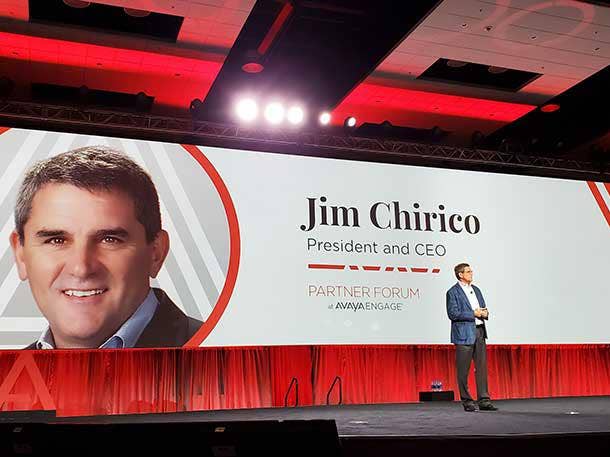Avaya CEO Jim Chirico On Beating Inertia And How Cloud, Subscriptions Will Cultivate Channel Growth
“I need the channel to sell the new,” Avaya's CEO Jim Chirico told CRN while discussing the UC giant’s pivot in favor of cloud and subscriptions to help Avaya return to growth.

The Importance Of Partnership
Avaya CEO Jim Chirico and his team had to hustle to turn around a company that in 2017 filed for bankruptcy. But Avaya has turned over a new leaf and is laser-focused on its new approach to the unified communications and contact center market by zeroing in on the cloud and a subscription-based buying model.
Avaya has had a legacy base of loyal VAR partners for years, but the company now needs the channel more than ever as it focuses on returning to growth through new, flexible offerings. To that end, Avaya wants to grow declining channel revenues by helping its partners make the pivot along with it towards next-generation services sold on a subscription basis.
Chirico met up with CRN at Avaya Engage 2020 to talk about changing up the company’s culture, the all-important Avaya/RingCentral relationship, and the strategy that Avaya has in place to help partners grow their business with cloud-based solutions and recurring revenue.
Here’s what Chirico had to say.

How instrumental are channel partners in helping Avaya return to growth?
Partners are going to be key. In the U.S., we do about 65 percent of our revenue through the channel and in the rest of the world, it's closer to 90 percent. The channel is really an extension of Avaya -- so goes the growth of the channel, so goes the growth of company.
We are seeing somewhere in the neighborhood of 10 percent erosion on the product side of our business through the channel over the past three years. As such, channel revenues have been down about ten percent. This year, we think we'll break even and that’s due to subscription and the cloud. And as we look into 2021 and beyond, we see growth.
How important is the subscription model for Avaya's business?
[The subscription model] isn’t rocket science and others have done this for quite some time. We have had to change the business model and really move to being much more flexible and personalized in our solutions, all built around our customer-led initiative that we have in the company. It's just been the inertia of the company -- It takes a while to get everyone to that point and shifting the culture of the company, but we've had great progress.

How significant is the availability of the subscription-based buying model for the channel?
It's significant on a number of fronts. Maintenance is sort of a thing of the past and people don’t really want to pay maintenance. We are pretty fortunate because the quality levels of our products are quite high, so people believe they are throwing money out the window. The other thing is, no matter what you do, you're always recasting or pricing down on your maintenance contract. Even if you are keeping the same customer base -- so your retention may be 100 percent -- your overall financial piece is only about 75-80 percent from a renewal dollars perspective. Another issue around maintenance is most companies overbuy and underutilize licenses.
Subscriptions help on a number of fronts. When we go to subscription, we balance out the number of licenses you actually need, so it’s really a benefit to our customer. Secondly, it gives you an OPEX model and OPEX for us gives us the ability to extend the contract for 3 to 5 years, so there's stickiness. And, we provide micros services on top of that we give away for free to further builds on partnership we have with customers. [Subscriptions] provide us predictability, a recurring revenue model stream that doesn’t have the same topline pressure as the contracts become due, and it provides a tremendous amount of flexibility for our customers. We are really seeing great market adoption on subscriptions.

Do you have goals in terms of moving more users to a subscription-based buying model as opposed to a CAPEX spend?
It's not applicable to everyone, but I would say at least 75 percent of our customers just based upon their portfolios. It won't fit all sizes, but I think it's going to get significant traction for us. We have some old CS1000 [Avaya/Nortel communication server systems] base out there from Nortel, and [those partners] are looking for opportunity to become relevant. We have a number of our IP office seats that we sold via software and we have a ton of software licenses out there that can move to subscription-oriented base. A lion's share of our 500 million [users] on contact center really fits because its moves from lower end of the midmarket up to the large enterprise.
What's the macro strategy to help legacy partners pivot to focus on cloud and subscriptions, and what kind of investments is Avaya making to help partners with the transition?
We have a couple things: One, we have invested significant dollars in [marketing development funds] MDF to help them from an overall marketing perspective and helping to position what we're are doing and how to train their sales organizations. For a number of top partners, we're actually funding customer success folks on their payroll -- especially in cloud -- to help generate sales associated with that. We are doing a lot of work on the channel front as far as providing our Edge partner program and putting significant economics on their side to the degree that they can grow their cloud seats and their business and actually get rewarded.

Will Avaya be kicking off any other partnerships similar to the RingCentral/Avaya relationship?
RingCentral was the biggest and most unique because they really are a true competitor and they also invested more back into the company than others have. Some partnerships we have invested in have invested back in us, but RingCentral is unique on a number of fronts and by far the largest.
Contact center has been our bread and butter and it's our true core competency, so I don't think you'll see things around contact center and that's why we're developing our own unique native architecture around the Contact Center as a Service space later this year. I don’t see anything else around [artificial intelligence] AI like we have with Google and Afiniti, and some others, or, maybe some other new technology that might be coming down the pike, but I don't see anything as impactful as you willas the RingCentral deal we signed late last year.

Why was it important for Avaya to embrace a partnership strategy with third-party tech providers?
We have always been a partner-centric company and use them mostly for fulfillment and distribution, but when you look at partnerships to bring tech to bear, we've dabbled in it and we use a lot of DevConnect-type partners [Avaya's marketplace of technology partners] that are more around specific applications as opposed to delivering a total solution.
The company had always been vertically integrated when it came to overall product and software R&D, and in in today's world, to move as quickly as startups are moving, to try to have that same structure; it's extremely unprofitable. Secondly, it's hard to get talent if you can afford the structure. Thirdly, it takes far too long and you fall behind in the innovation curve. About two years ago, we set a dedicated company initiative to really to figure out how to not only to embrace partnerships, but how to make them more successful. Before that, we were trying to do tech tuck-ins and M&A and this came with their own myriad of problems. We found out folks would prefer to partner with you, and it’s a win-win for both companies. We have been at this now for a couple years, and in the last 24 months, we've added 40 strategic partnerships across different technology segments, so it's been successful.

How big is the partner opportunity around device as a service?
In the channel, to be honest, our device as a service has been [available] for about 6 months but revenues are below expectations. It may pick up a bit more with cloud as we now have a new cloud offering [Avaya Cloud Office powered by RingCentral (ACO)], but most of who we sell to, to buy a phone outright or pay $3 a month for a phone, really isn't a big differentiation. If you’re an SMB play, which we are doing with cloud and ACO -- we'll have a bit more of uptick, especially as we go through the master agent channel, but for our general business, it's an option, but not too many people have checked the box.
Avaya is obviously a company that has gone and is still going through a major transition. What's your message to partners right now?
I want to thank the partners for all they've done for Avaya - it’s a significant part of our overall revenue for the company. My second message is: be all in. What I mean by that is, our product portfolios are changing, the industry is changing, and I need the channel to sell the new. Help sell subscription, our private cloud offer, as well as our new ACO offer which will be available later this quarter. We are looking to expand the overall portfolio, the offers, and we are looking for you to help us grow and get back to revenue growth and market share expansion.